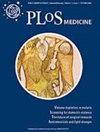低剂量阿司匹林预防早产:问题多于答案。
IF 10.5
1区 医学
Q1 MEDICINE, GENERAL & INTERNAL
引用次数: 4
摘要
本文章由计算机程序翻译,如有差异,请以英文原文为准。
Low-dose aspirin for the prevention of preterm birth: More questions than answers.
Preterm birth (birth before 37 weeks gestation) is the leading cause of neonatal mortality, is associated with long-term disability in survivors, and carries a substantial economic burden to healthcare and social services [1]. There is increasing interest in the use of aspirin as a preventative treatment for preterm birth. Low-dose aspirin prophylaxis is well established in women who are at high risk of hypertensive disorders in pregnancy. Meta-analysis of trial data shows that low-dose aspirin taken from early pregnancy is beneficial for reducing the incidence of preeclampsia and its associated complications, including preterm birth [2]. The majority of preterm births associated with preeclampsia are provider initiated, resulting from preterm cesarean section or induction of labour indicated by worsening maternal or fetal condition. Nevertheless, reanalyses of data from trials of aspirin to prevent preeclampsia have also shown small but statistically significant reductions in spontaneous preterm birth (preterm birth preceded by the spontaneous onset of contractions or preterm prelabour rupture of membranes) [3,4]. As spontaneous preterm births are the biggest contributor to preterm birth overall, the question of whether aspirin can be used to prevent spontaneous preterm births has arisen. There has been little data from primary trials to guide practice in this area. In an accompanying research study in PLOS Medicine, Landman and colleagues report on a randomised controlled trial designed to assess the effectiveness of low-dose aspirin in the prevention of preterm birth in women at high risk of preterm birth [5]. Women with a previous spontaneous preterm birth between 22 and 36 weeks gestation (a recognised risk factor for recurrent preterm birth) were eligible to participate in the APRIL (aspirin for the prevention of recurrent spontaneous preterm labour) trial. Participants were randomised to daily aspirin 80 mg or placebo, initiated between 8 and 16 weeks gestation, and continued until 36 weeks gestation. The primary outcome was any preterm birth before 37 weeks gestation (i.e., included both spontaneous and provider-initiated preterm births). Although a small reduction in recurrent preterm birth was observed in women taking low-dose aspirin, this was not statistically significant (21% preterm birth rate in women randomised to aspirin compared to 25% preterm birth in those randomised to placebo). Unfortunately, with 406 participants, the APRIL trial was underpowered to provide a definitive answer for the primary outcome of preterm birth. The sample size calculation for the APRIL trial was based on a potential 35% relative reduction in the rate of preterm birth (which the authors state was based on the average risk reduction in preterm birth seen in secondary analyses of other trials of aspirin), from a background rate of 36%. This background rate was derived from a trial of progesterone to prevent preterm birth which recruited participants from the United States in the late 1990s, but is higher than that cited in more recent literature, especially if other preterm birth treatments are PLOS MEDICINE
求助全文
通过发布文献求助,成功后即可免费获取论文全文。
去求助
来源期刊

PLoS Medicine
医学-医学:内科
CiteScore
21.60
自引率
0.60%
发文量
227
审稿时长
3 months
期刊介绍:
PLOS Medicine aims to be a leading platform for research and analysis on the global health challenges faced by humanity. The journal covers a wide range of topics, including biomedicine, the environment, society, and politics, that affect the well-being of individuals worldwide. It particularly highlights studies that contribute to clinical practice, health policy, or our understanding of disease mechanisms, with the ultimate goal of improving health outcomes in diverse settings.
Unwavering in its commitment to ethical standards, PLOS Medicine ensures integrity in medical publishing. This includes actively managing and transparently disclosing any conflicts of interest during the reporting, peer review, and publication processes. The journal promotes transparency by providing visibility into the review and publication procedures. It also encourages data sharing and the reuse of published work. Author rights are upheld, allowing them to retain copyright. Furthermore, PLOS Medicine strongly supports Open Access publishing, making research articles freely available to all without restrictions, facilitating widespread dissemination of knowledge. The journal does not endorse drug or medical device advertising and refrains from exclusive sales of reprints to avoid conflicts of interest.
 求助内容:
求助内容: 应助结果提醒方式:
应助结果提醒方式:


